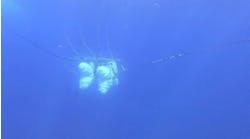Composite drilling riser systems will soon be a reality. ABB Vetco Gray is joining other equipment firms preparing to market composite based riser systems, and will introduce both full composite and hybrid riser technology in a three-phase approach, beginning with composite choke and kill lines.
The company has been working on composite-based systems for four and a half years, according to Gary Galle, Manager of Systems Development for the firm's R&D department. The company has focused efforts on three areas, composite choke and kill lines for drilling risers, composite drilling risers, and composite production risers. The first of these to be commercialized is the choke and kill lines.
There are a variety of advantages that composite riser systems offer operators in deepwater. Justin Whitehead, Senior Engineer in Systems Development, said the composite systems require less buoyancy than steel counterparts. This means less syntactic foam and smaller modules on riser joints. The encased joints will have a smaller outer diameter.
More riser joints can be stored on the deck and they will fit through a smaller rotary table. Also, the lighter joints mean a smaller deckload and a lighter riser string. A lighter string requires less top tension. The savings on deckload also means a rig could carry extra casing strings when drilling in deepwater and ultra-deepwater.
Deepwater savings
ABB Vetco Gray built this composite pup joint for testing purposes.
Overall, a riser system with composite auxiliary lines could save as much as $2 million for a rig drilling in 5,000 ft water depth.
In greater depths, Whitehead said the savings rise because such a system could avoid the need to upgrade an entire rig. This upgrade involves downtime, drydock expenses, in addition to the cost of the modifications.
The choke and kill lines can be swapped out for the current steel lines on an existing deepwater riser system, Galle said. This saves the cost of a complete new riser and can save in the area of 25% of the weight of a steel riser. Such savings would allow third generation semisubmersibles (3,000 ft capable) to drill in water depths of 5,000 ft with out a major upgrade.
In addition to the ease of installation and cost savings of these choke and kill lines, there is the advantage of incremental change. Galle said the industry is slow to adopt composite technology. But accepting composite material in choke and kill lines will hopefully open the door to composite riser systems.
Testing
In addition to rigorously testing these composite materials used in these lines, ABB thoroughly tested the inner and outer liners that seal the composites. Eric Pierce, Composite Technologies EIT in Research and Development for ABB Vetco Gray said 10 ft samples of the choke and kill lines were built for testing purposes. These carbon fiber tubulars would be lined with thermoplastic on the inside and sealed at the ends with a proprietary mechanical seal.
The liners and seals at the end were tested in conditions that simulated 80 years of service life before they were combined with the composites and tested as a unit. The 4.5-in. internal diameter lined tubulars also have an exterior rubber-based liner. This system was run as a bare joint and encased in foam.
The first wet trials of this system, Galle said, will be for Petrobras on the P-17 offshore Brazil this year.
Drilling risers
ABB Vetco Gray also is working with Petrobras to install the first full-size, 21-in. drilling riser with composite tubulars and choke and kill lines. Such a system could save around 60% of the weight of a steel riser system, Galle said. While a composite riser system would be more expensive than a comparable steel system, it would not be necessary that all the joints be composite. Using heavier steel joints in the lower riser section would provide more stability and ease the running process for the composite system. The individual riser joints can be purchased to extend an existing steel riser system or as a newbuild system.
This system also experienced extensive testing, undergoing 750,000 fatigue cycles, Galle said. These tubulars feature a thermoplastic inner liner and rubber-based outer liner. The inner liner would be designed for the specific wear conditions of an operating environment. As the liner wears, Galle said it could be replaced in the field.
Flange connection
The key design challenge in introducing a composite drilling riser is the connection between the composite tubular and the steel flange. Because of the complex stresses the flange undergoes, it is not practical to design a composite flange. There has traditionally been concern that the connection between the steel and composite material is a weak point in this design. Galle said ABB Vetco Gray has a unique approach to this connection.
The company attaches the steel and composite material winding the composites over the tailpiece of steel. Then the connection is preloaded. The gap that is created between the two materials is evacuated and filled with a noncompressable fluid. When the load is released, this preloading maintains consistent operational loads. Because the cycle load is minimized, there is much less fatigue created at each cycle loading.
The preloading also compensates for the difference in coefficients of thermal expansion between the carbon fibers and the steel. When the composite materials are cured under heat, there is a mismatch in the rate of contraction between the cooling composites and steel. Preloading compensates for the mismatch.
The same technology ABB Vetco Gray is applying to its development of a composite drilling system will be used in creating a composite production riser. Pierce said the company is focusing on the drilling side, but will then move into production risers.




